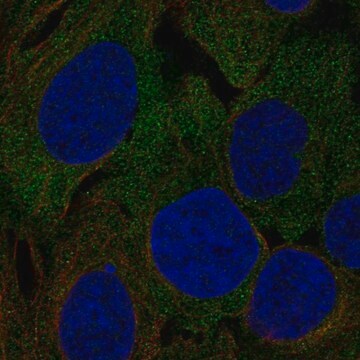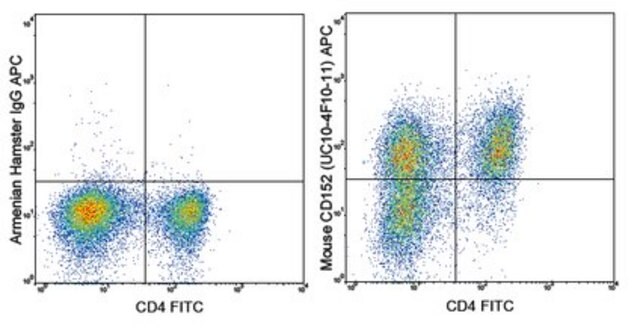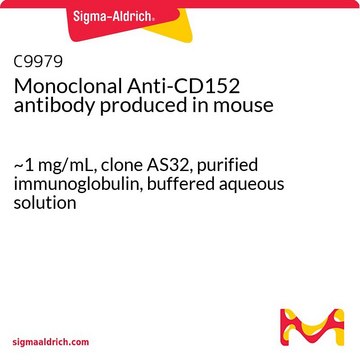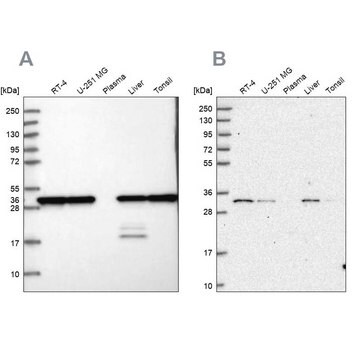04-963
Anti-CTLA4 (CD152) Antibody, clone 9H10
clone 9H10, from hamster
Sinonimo/i:
CD152 antigen, Cytotoxic T-lymphocyte-associated antigen 4, celiac disease 3, cytotoxic T-lymphocyte-associated protein 4, cytotoxic T-lymphocyte-associated serine esterase-4, ligand and transmembrane spliced cytotoxic T lymphocyte associated antigen 4
About This Item
Prodotti consigliati
Origine biologica
hamster
Livello qualitativo
Forma dell’anticorpo
purified immunoglobulin
Tipo di anticorpo
primary antibodies
Clone
9H10, monoclonal
Reattività contro le specie
mouse
tecniche
flow cytometry: suitable
immunoprecipitation (IP): suitable
western blot: suitable
Isotipo
IgG
N° accesso NCBI
N° accesso UniProt
Condizioni di spedizione
wet ice
modifica post-traduzionali bersaglio
unmodified
Informazioni sul gene
human ... CD28(940) , ICOS(29851)
Descrizione generale
Specificità
Immunogeno
Applicazioni
FACS analysis of ConA (24 hours) stimulated BALB/C splenocytes for surface expression of CTLA-4 (CD152). Cells were stained with 10 ug of biotin-labeled hamster anti-CTLA-4 ,clone 9H10 (open histogram) or with PE-Sav secondary antibody alone (histogram, Figure B). Note the distinct signal difference between the control (dark control histogram) and test (clear histogram).
Immunoprecipitation: Clone 9H10 is widely used for immunoprecipitaiton of CTLA-4; recommended lysis buffers include 1% NP40; 0.5% triton X-100 with proteinase inhibitors; 1-5 µg of 9H10 is added to 300-500 µL of whole cell lysate or cell membrane protein preparations (250-500 mg/mL totall protein) and incubated 3-6 hours at 4°C, followed by capture with protein G beads following standard immunoprecipitation methods (Zhang, Y., et al., 1997).
Inflammation & Immunology
Transcription Factors
Inflammation & Autoimmune Mechanisms
Qualità
Western Blot Analysis: 1 µg/mL of a biotinylated version of this antibody detected CTLA4 in 10 µg of mouse spleen lysate.
THIS ANTIBODY IS NO BIOTINYLATED.
Descrizione del bersaglio
Stato fisico
Stoccaggio e stabilità
Risultati analitici
Mouse spleen cell lysate
Altre note
Esclusione di responsabilità
Non trovi il prodotto giusto?
Prova il nostro Motore di ricerca dei prodotti.
Codice della classe di stoccaggio
12 - Non Combustible Liquids
Classe di pericolosità dell'acqua (WGK)
WGK 1
Punto d’infiammabilità (°F)
Not applicable
Punto d’infiammabilità (°C)
Not applicable
Certificati d'analisi (COA)
Cerca il Certificati d'analisi (COA) digitando il numero di lotto/batch corrispondente. I numeri di lotto o di batch sono stampati sull'etichetta dei prodotti dopo la parola ‘Lotto’ o ‘Batch’.
Possiedi già questo prodotto?
I documenti relativi ai prodotti acquistati recentemente sono disponibili nell’Archivio dei documenti.
Il team dei nostri ricercatori vanta grande esperienza in tutte le aree della ricerca quali Life Science, scienza dei materiali, sintesi chimica, cromatografia, discipline analitiche, ecc..
Contatta l'Assistenza Tecnica.







